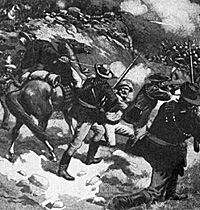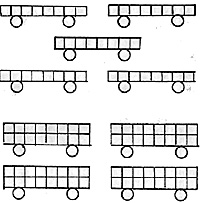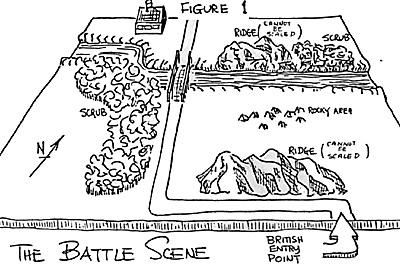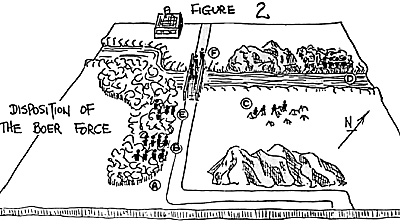BACKGROUND
 This article describes a set of miniatures skirmish rules and a wargame encounter between British and Boer troops, circa 1900. The battle was fought with ROYALS, a series of 30mm
British Colonial figures, mounted singly. The skirmish was small - a total of some 60 men were involved - and good use was made of casualty figures for visual effect, together with
seperate castings for cavalry troopers in the mounted and dismounted positions.
This article describes a set of miniatures skirmish rules and a wargame encounter between British and Boer troops, circa 1900. The battle was fought with ROYALS, a series of 30mm
British Colonial figures, mounted singly. The skirmish was small - a total of some 60 men were involved - and good use was made of casualty figures for visual effect, together with
seperate castings for cavalry troopers in the mounted and dismounted positions.
THE SCENARIO
ED NOTE: This scenario will be use in an HMGS/PW tournament at ORIGINS '82.
A sketch of the terrain, Figure 1, shows a road running north-south, leading to a bridge which is the key terrain feature.
At the outset, a small party of Boers, 4 in number, is perched upon the bridge, chopping away furiously, hoping to destroy it to prevent the British patrol, entering from the southern edge of the table, from capturing the bridge intact.
The bridge is shielded from the British entry point by a large ridge; this gives the Boer party a "free" whack at the bridge on the first turn before they are sighted. They will come under fire on the second turn as the British move around the ridge.
Along the western edge of the road is a scrub undergrowth, good for initial obscurity for any nasty Boers mean enough to want to ambush the oncoming British. The undergrowth permits them to get in first fire; when they do fire, the bushwacking Boers are revealed and are placed on the table the scrub provides no impediment to movement and no bonuses or detriments in melee. The same holds true for the other scrub area shown, on the northeast bank of the river. The scrub does provide a cover modifier when a unit in it is fired upon.
Each turn, the Boers on the bridge get a crack at destroying one quarter of the bridge structure. The chance of demolishing the quarter section is equal to the morale level of the Boer party. As they take casualties, their morale level decreases.... but if they're lucky, if they can hold up under fire, if they can stay on the bridge, and if they can roll lots of low dice, they can chop through in 4 bounds.
In 4 bounds, however, the British will be at point blank range. Their entry point is placed such that, if the oncoming patrol is not impeded (moving at 10 inches per bound), they can be on the bridge in 5 bounds.
The forces involved were: British: Cavalry, 2 squads; Infantry, 4 squads; Askaris, 3 squads; Rapid-fire gun, 1 squad. Boers: Irregulars, 6 quads.
THE RULES
Movement
Movement is governed by the draw of cards. Each unit on the table is assigned one card; all cards are shuffled into one deck. When a card is drawn, the unit designated on the card may move, or fire, or both. The options are:
Move 10 inches, or Move 5 inches and fire one round, or Hold and fire 2 rounds.
Cavalry movement is unique. The cards in the movement deck designate when the men in each unit may perform an action. There is one card in the deck, therefore, for each troop of cavalry, on which, when the card is drawn, the troopers themselves may mount, fire, dismount, move on foot, etc. This card, therefore, is a "trooper" card, not a "horse" card. The actual movement of horses, i.e., of mounted troopers, is accomplished simply by moving all cavalry 5 inches on every other card draw.
The Turn Sequence
a. Draw card; designated unit fires, moves, etc. b. Draw card, designated unit fires, moves, etc. c. Move all mounted troopers 5 inches d. Draw card; designated unit fires, moves, etc. e. Draw card; designated unit fires, moves, etc. f. Move all mounted troopers 5 inches then back to a.
Thus in between every two drawn cards, the cavalry "flows" forward 5 inches. The cavalry commander may stop his unit on any one of the "flow" phases; the troopers, however, may not dismount or take any action until their own card is drawn. When troopers dismount, they may:
Dismount and tether their horses, or Dismount and move 5 inches, or Dismount and fire one round
In the case of the first two options, the horses are untethered and will continue to move away from the troopers during the "flow" phases, unless one man is designated as horse holder.
Note that the cavalry charge is accomplished simply by pointing the horses in the right direction and letting the unit "flow" towards the target; no charge move increment is given.
Firing
 Each British soldier carries 50 cartridges. If the fire phase of a
bound is somewhere near 30 seconds or so, a man may
rapid fire 10 shots from his bolt action rifle within this period.
Thus he can exhaust his 50 cartridge allotment in 5 bounds.
For ease of play, each burst of 5 shots is considered one
"round", and so each British soldier should be given 10
"rounds" for the game. Just to make it a wee bit more difficult
for the British, they're actually given only 8 rounds. The data
sheet for a British squad of 5 men looks like:
Each British soldier carries 50 cartridges. If the fire phase of a
bound is somewhere near 30 seconds or so, a man may
rapid fire 10 shots from his bolt action rifle within this period.
Thus he can exhaust his 50 cartridge allotment in 5 bounds.
For ease of play, each burst of 5 shots is considered one
"round", and so each British soldier should be given 10
"rounds" for the game. Just to make it a wee bit more difficult
for the British, they're actually given only 8 rounds. The data
sheet for a British squad of 5 men looks like:
As each round is fired, one of the rectangular boxes is crossed off. The circles below the ammunition supply boxes are "wound boxes" . . . 2 wounds will kill a man.
Boers never seem to run out of ammunition; they are given 16 rounds each. A 4 man Boer squad data sheet looks like:
The basic probability-of-hit (POH) is a function of range. The Range Factor (RF) is:
- RF = (50 - Range in inches) so that rifles reach out to 50 inches. The Range Factor for a unit is then multiplied by the number of rounds (N) fired by the unit. Hence a British
squad of 5, halted, with each man firing 2 rounds (10 rounds total) at a range of 32 inches, results in:
- POH = N X RF = 10 x (50-32) = 180
The POH of 180 means one sure hit and an 80% chance of a second hit.
Whenever a hit occurs, the men in the target unit are numbered and a die is thrown to determine which man was hit. It well may be, therefore, that one poor unfortunate suffers multiple hits even though 2 are sufficient to kill him.
The POH may be further modified by the following factors:
- Target located in scrub or undergrowth. . x 1/2
Target behind hard cover ... X 1/2
Firing while mounted... X 1/2
Hasty fire ... X 1/2
Target unit in close order ... X 1 1/2
The "hasty fire" modifier is used only on a contact move. The charging unit's card is drawn, and it declares a charge, whereupon the defending unit gets an out-ofsequence "hasty fire" (each man may fire one round) at the oncoming squad.
A machine gun may fire 3 bursts, of up to 10 rounds each, every time it fires (when the gun crew's card is drawn). Its ammunition supply totals 100 rounds. Prior to every burst, a check is made to see if the gun jams (20% chance) and this figure is cumulative. The gun, therefore, cannot fire more than 5 bursts without jamming. One complete gun crew card is required to "unjam" the mechanism.
Melee
When units contact one another, only positive modifiers are used to ascertain th combat points of each figure. Modifiers are all "plus tens"; just about any positional advantage rates a +10 for a man in melee.
Thus each British lancer, in a 5 man unit, charging downhill at 5 Boers, receives the following:
- +10 for his lance
+10 for his horse
+10 for his impetus
+10 for his downhill charge
The Boers stand there and receive nothing. No "plus tens" for them. Each lancer receives 40 points, each Boer gets nothing.
Having totaled the points for each figure in the melee, now set the lesser valued man at a reference level of 25 points. Here, if we set each Boer to 25, then the lancer is 40 above that, or 65 points. Now total the unit value: 5 lancers at 65 each = 325%; 5 Boers at 25 each = 125% ' The lancers kill 3 and have a 25% chance of a fourth; the Boers kill one and have a 25% chance of a second.
Note that, unlike firing, which takes off one wound box for each hit, melee hits indicate a KILL, i.e., 2 wound boxes, and figures are removed. In a multi-man melee, if a kill occurs, dice to see which men are carted off. After each round, both sides check morale, and only if both pass will a subsequent round be fought. Multiple rounds are fought on the same bound until one side or the other breaks.
When a charge is declared, note that if the defending unit successfully passes its morale test, it gets to fire "hastily" at the attackers. If it doesn't pass, it doens't get to fire, but it also doesn't get to run ... there will always be at least one round of combat.
The results of the pre-melee morale check of the defending unit will be one of the following (U, Q, and R are defined in the section on morale):
- a. Defending unit receives a it holds and fires hastily U
b. Defending unit receives a it holds and fires hastily, the attacking unit receives a +10 in melee Q
c. Defending unit receives a it holds, but does not fire, and the attacking unit receives a +10 in melee. R
Morale
There are 3 morale status levels: U, Q and R.
- Unaffected: unit obeys orders
Questionable: unit's reaction on the next turn unknown; it is diced for
Rout . . .unit runs back, not facing, in disorder.
Morale is checked when a unit is charged, or receives casualties - either through fire or melee. Each unwounded man in a unit is valued at 20 morale points. A wound reduces the 20 to a 10. Unit sizes reflect the relative initial morale of each nationality:
| NATIONALITY | UNIT SIZE | INITIAL MORAL LEVEL |
|---|---|---|
| British | 5 men | 5 x 20 100 |
| Boer | 4 men | 4 x 20 80 |
| Native Askari | 3 men | 3 x 20 60 |
When morale is tested, the following chart is used:
| Moral Level | Percentage Die Throw | |||||||||
|---|---|---|---|---|---|---|---|---|---|---|
| 1 | 2 | 3 | 4 | 5 | 6 | 7 | 8 | 9 | 0 | |
| 10 | R | R | U | R | R | Q | Q | R | R | R |
| 20 | R | R | R | Q | U | Q | R | Q | R | Q |
| 30 | Q | R | Q | R | Q | R | R | Q | Q | R |
| 40 | U | Q | Q | Q | U | R | Q | R | Q | R |
| 50 | Q | Q | U | R | Q | Q | U | R | U | U |
| 60 | Q | Q | R | U | U | Q | U | Q | R | U |
| 70 | U | Q | U | U | U | U | R | Q | U | Q |
| 80 | U | U | U | Q | U | Q | U | U | U | R |
| 90 | U | Q | U | U | U | U | U | U | U | U |
| 100 | U | U | U | U | U | Q | U | U | U | U |
One percentage die is thrown and correlated with the unit's morale level. A 4 man Boer unit, with one man wounded, has a morale level of 70. If a 6 is thrown on their morale check, the result, from the chart is a U; they obey orders.
If the result is a Q, for Questionable, the unit's response on its NEXT card draw is determined as follows:
- a. The squad is given orders to fire, move, etc.
b. Percentage dice are thrown and the following table is used:
-
01 to 33 Unit obeys its orders
34 to 67 Unit holds, does nothing
68 to 100 Unit falls back 6 inches, facing
If a unit is already in a Questionable state, and is forced to check morale, then 10 points are DEDUCTED f rom the morale level with which it enters the table. It may, after checking its status, receive another Questionable. In such case, when its card is drawn, and it becomes the squad's turn to act, ADD ten to the dice throw above to see if it obeys, or holds or falls back. Note that this uses up only the first of the two Questionables assigned; on the next turn it again must go through the dice throwing routine for the remaining Questionable.
There is, in addition to the requirement of an immediate morale check due to casualties from fire and melee, one special situation which calls for a unit morale test. Due to the undependability of Askari units, these troops are subject to a special check if a British unit routs past them. When this is done, instead of entering the morale chart at their full morale level, the special test is made by entering at one half their morale level.
THE BATTLE
 Pete Reese and Steve Payne were lucky enough to have
visited while the rules were in preparation and were invited to
play. They proved an excellent pair on which to experiment, for
Pete - who assumed command of the Boers and shall
henceforth be referred to as the Commandant - is a
boardgamer, while Steve - hereinafter referred to as the
Colonel - is an avid Napoleonics miniatures buff. Neither
were familiar with the rules.
Pete Reese and Steve Payne were lucky enough to have
visited while the rules were in preparation and were invited to
play. They proved an excellent pair on which to experiment, for
Pete - who assumed command of the Boers and shall
henceforth be referred to as the Commandant - is a
boardgamer, while Steve - hereinafter referred to as the
Colonel - is an avid Napoleonics miniatures buff. Neither
were familiar with the rules.
The Commmandant set out his men, six 4 man squads, by designating their positions on the map. Immediately a problem arose ... the good burgher wished to group two units of Boers in the scrub at Point A on Figure 2 and greet the British with a ton or so of lead before they even rounded the ridge. While tactically a wonderful move, "gamewise" this would have been devastating, and so it was ruled that Point B was the farthest south that the Boers could be placed. The initial positions are shown in Figure 2: two units were hidden at Point B, and one each in the rocks at C, the scrub at D, and scrub at E. The sixth Boer squad was placed on the bridge, axes and crowbars poised expectantly, waiting for their card to be drawn to begin the work of demolishing the bridge.
One of the Colonel's two 5 man cavalry units went around the east end of the ridge and headed straight north. Heavy firing, many casualties . . . eventually 2 mounted troopers reached the river at Point D. Attempting to cross and make contact, they were greeted with "Hasty fire" (half effect) from the 4 man Boer unit in the scrub. One trooper survived, wounded ... a die throw, a quick look up in the morale table (his morale level, wounded, was at 10), and he turned his horse and fled south.
The other cavalry unit headed west, attempting to skirt the undergrowth. One of the Boer squads at Point B made short work of these men, and they, too, routed back.
 The lone trooper routing from the attempted river crossing at
Point D caused other problems for the British. The native
Askari units, 3 of them, were moving north, having come
around the east end of the ridge. The rules stipulate that if a
British unit routs past a native unit, the Askaris check morale
... and in doing so, they will enter the morale chart at half their
current morale level. The 3 man Askari squads start out at a
morale level of 60, no bargain in itself ... as the British cavalry
trooper routed by, each of the 3 Askari units checked by
entering the chart at a morale grade of 30. The result,
unsurprisingly, was a complete disruption of the Askari units,
and the British advance on the right flank came to a halt.
The lone trooper routing from the attempted river crossing at
Point D caused other problems for the British. The native
Askari units, 3 of them, were moving north, having come
around the east end of the ridge. The rules stipulate that if a
British unit routs past a native unit, the Askaris check morale
... and in doing so, they will enter the morale chart at half their
current morale level. The 3 man Askari squads start out at a
morale level of 60, no bargain in itself ... as the British cavalry
trooper routed by, each of the 3 Askari units checked by
entering the chart at a morale grade of 30. The result,
unsurprisingly, was a complete disruption of the Askari units,
and the British advance on the right flank came to a halt.
On the other flank, Colonel Payne had chosen to hold and fire fight with Boers at Point B. This brought the left flank to s standstill.
The Colonel's machine gun crew managed to get their gun set up, aimed towards the bridge but heavy Boer fire drove them back from the gun. i.e., a Questionable response resulted in a fall back, and they failed to fire even a single shot during the encounter.
Three British squads focused on the Boers at Point B. The British units were hampered by cross fire from the Boer squads in the rocky area at C, and in the brush at Point E.
British Squad #1 won the laurels of the day in the losing fight. Formed in close order, they charged the Point B Boers and routed one of the two units. Still in close order, they contacted the second Boer squad, and that group was sent fleeing. The fire effect on close order troops is 50% greater than on open order (the rules consider open order to be the "norm") and Squad #1 was hard hit. Despite this, they went through both Boer units at Point B, somehow managing to pass all morale throws.
All the foregoing happened during the first 4 bounds. The Commandant, seeing the entire British force brought to a halt a safe distance down the road, ordered his 4 man squad on the bridge to drop their crowbars, pick up their Mausers, and join the fire fight. The bridge unit had previously demolished a quarter of the structure; the Commandant saw no need to continue to work on the bridge if the British weren't even going to reach it.
And held up, indeed, the British were . . . on the 5th bound, the Colonel acknowledged defeat and ordered his surviving troops to pull back.
THOUGHTS ON THE BATTLE
The colonel erred in concentrating solely on the Boers at Point B. He could have detached one squad to keep them busy, while the rest of his units advanced up the road. They would have taken heavy fire, but it would have made the Commandant think twice ... as it was, the crew on the bridge was never in danger and, had they so desired, they could have used screwdrivers to dismantle the bridge and pack it up, so much time did they have.
In several replays of the scenario, the best British tactic appears to be to send the cavalry out to the west on the long ride around the scrub. "Flowing" at 5 inches per move, every two cards, the cavalry get to where they're going in rapid fashion. Once having reached the western end of the river, the troopers can either dismount and start off into the scrub to harass the bridge party, or can cross the river, still mounted, and circle clockwise to attack the Boers from the rear. Either way, the cavalry acts to divert one or two Boer squads from focusing on the advancing British infantry.
Another British tactic would seem to be to send the Askari units way out in front of the regular British squads. The Askaris' morale level is quite low to start with, and so they cannot be used as a reserve; they can, however, serve as an effective shield, soaking up fire which would ordinarily have been directed at the oncoming British troops.
And the Boer tactic? Hit the British early in the game while keeping one squad near the group on the bridge, so that if the party of wreckers does get hit and fail morale the second squad can immediately take its place.
Back to Table of Contents -- Courier Vol. III #6
To Courier List of Issues
To MagWeb Master Magazine List
© Copyright 1982 by The Courier Publishing Company.
This article appears in MagWeb (Magazine Web) on the Internet World Wide Web.
Other military history articles and gaming articles are available at http://www.magweb.com